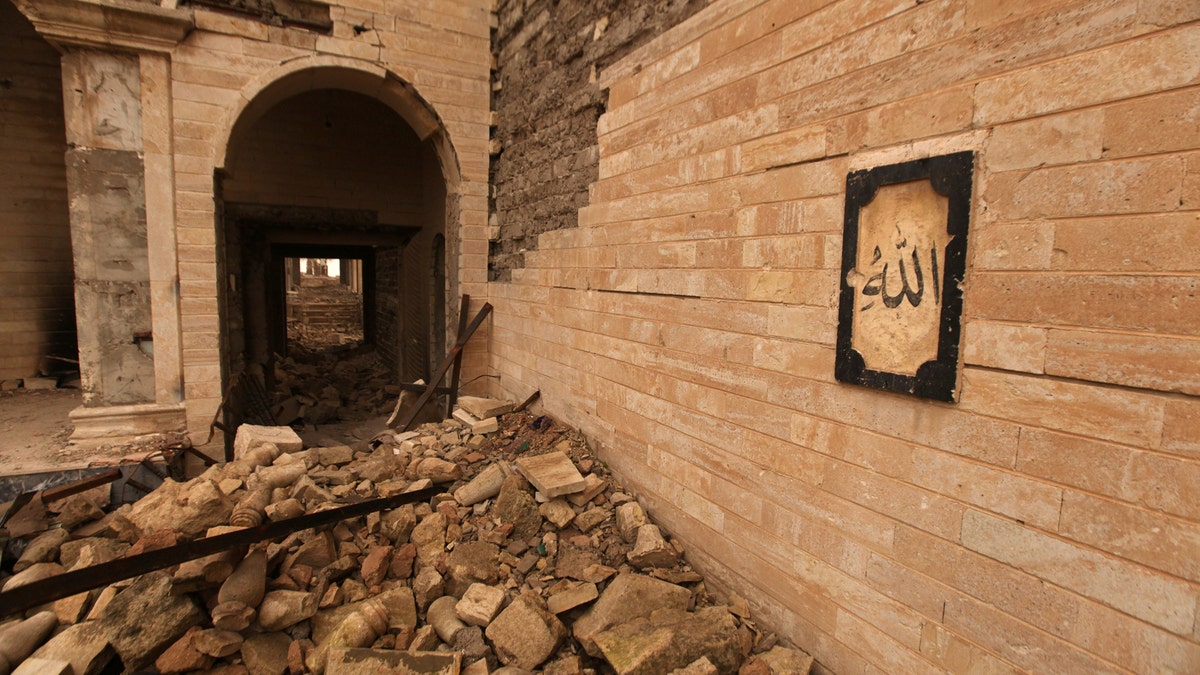
The remains of the Tomb of Prophet Yunus, destroyed by Islamic State militants, in Mosul, Iraq, January 28, 2017. (REUTERS/Azad Lashkari)
Archaeologists in Mosul have made a stunning find beneath the Tomb of the Prophet Jonah that was destroyed by Islamic State militants in 2014: the long-hidden palace of ancient Assyrian King Sennacherib.
Experts were documenting the jihadists’ destruction of the tomb’s ruins when they located the palace, which dates back to 600 B.C. ISIS had dug tunnels into the site in a search for ancient artifacts to plunder, according to media reports.
The Telegraph reports that Iraqi archaeologist Layla Salih found a marble cuneiform inscription of Assyrian King Esarhaddon inside one of the tunnels. The inscription is believed to date to 672 B.C. when the palace was part of the ancient Assyrian city of Nineveh.
TREASURE HUNTERS STRIKE GOLD WITH ANCIENT JEWELRY FIND
One of the earliest forms of writing, cuneiform harnesses wedge-shaped marks and was widely used in ancient Mesopotamian civilizations.
The palace was built for the Assyrian King Sennarcherib, expanded by his son Esarhaddon, and renovated by his grandson King Ashurbanipal, according to the Telegraph, which notes that the palace was partly destroyed during the sack of Nineveh in 612 B.C. Sennacherib’s invasion of the ancient kingdom of Judah is extensively documented in the Bible. Esarhaddon and Ashurbanipal are also mentioned in scripture, although feature less prominently.
Elsewhere in the tunnel, archaeologists found ancient Assyrian stone sculptures of a demi-goddess, the Telegraph reports.
ANCIENT HONORS: INSCRIPTIONS UNCOVERED AT SYNAGOGUE IN ISRAEL
The Tomb of Jonah, or Nebi Yunus in Arabic, is located on a hill in Eastern Mosul. The site was recaptured from ISIS by the Iraqi army last month during its Mosul offensive.

The remains of the Tomb of Prophet Yunus, destroyed by Islamic State militants, in Mosul, Iraq, Jan. 28, 2017. (REUTERS/Azad Lashkari) (REUTERS)
Jonah is revered in Christian, Muslim, and Jewish traditions. The Prophet’s tomb, which was located within a Sunni mosque, was destroyed by ISIS militants in July 2014.
Dr. Paul Collins, Chair of The British Institute for the Study of Iraq, which is working with the Iraqi State Board of Antiquities and Heritage and UNESCO to protect Iraq’s cultural heritage, told Fox News that there could be more damage at the site. “The tunnels, probably dug for looting, are in imminent danger of collapse,” he explained, via email. “If this happens the result will be even more destruction at a site that had already been devastated by the explosions that destroyed the ancient Shrine of Jonah - in effect we will lose a place where Iraq's ancient, medieval and modern cultural heritage rests one above the other.”
FOR THE LATEST SCIENCE FEATURES FOLLOW FOX SCITECH ON FACEBOOK
Archaeologists have been aware since the nineteenth century that ancient Assyrian royal buildings are beneath the shrine, according to Collins, who notes that inscriptions and a relief from a dig in the 1870s are now in the British Museum. “Iraqi excavations in the 1950s revealed an entrance to an Assyrian royal arsenal and in 1990 a large Assyrian building to the east of the mosque guarded by colossal human-headed winged bulls was excavated, but this work came to an end with the Iraq/Kuwait war,” he said.
Follow James Rogers on Twitter @jamesjrogers








































